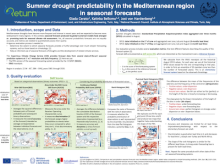Summer droughts predictability in the Mediterranean region using seasonal forecasting systems
Giada
Cerato
Politecnico di Torino, Department of Environment, Land, and Infrastructure Engineering, Turin, Italy
Poster
The Mediterranean region is increasingly vulnerable to extreme drought events, as suggested by recent observations showing a rise in both their occurrence and intensity. These prolonged dry spells pose substantial threats to agriculture and economies, impacting various socio-economic sectors. In this context, long-range weather forecasts have emerged as a promising tool for seasonal climate risk assessment. In this study, we evaluate the predictability of summer droughts in the Mediterranean basin in the state-of-the-art seasonal prediction systems provided by the Copernicus Climate Change Service (C3S). Drought events are detected using the Standardised Precipitation Evapotranspiration Index aggregated over three- and six- months (SPEI3 and SPEI6) in August. Given the probabilistic nature of the prediction systems, a rigorous evaluation process is necessary to evaluate the quality of the forecasted drought probabilities. Our analysis employs a comprehensive set of evaluation metrics to derive information on the prediction systems’ quality in
forecasting droughts in terms of association, discrimination and sharpness. Despite some capabilities being evident, the ensemble skills are sensible to the selected lead time, and vary across different regions. Therefore, cautious consideration is mandatory before employing the forecasting products for societal applications.
forecasting droughts in terms of association, discrimination and sharpness. Despite some capabilities being evident, the ensemble skills are sensible to the selected lead time, and vary across different regions. Therefore, cautious consideration is mandatory before employing the forecasting products for societal applications.

Poster file
Cerato_Giada_blocking_poster.pdf
(7.69 MB)
Meeting homepage
